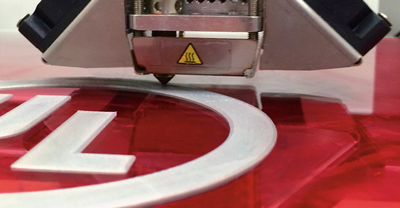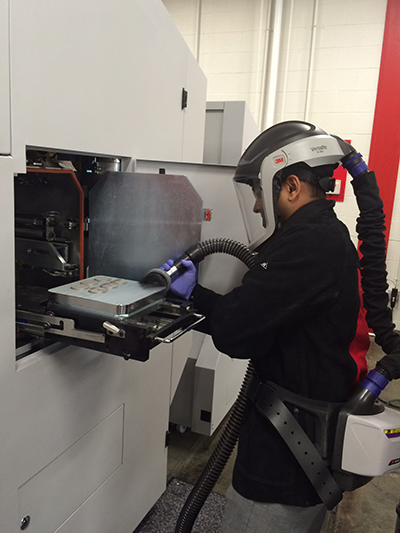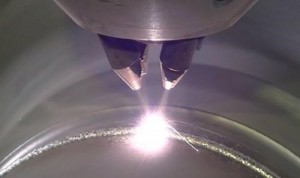The lack of global product standards and certification, as well as insufficient process knowledge and operator training by users, threaten to hinder some aspects of the fast-growing additive manufacturing sector.
Commonly called 3-D printing, additive manufacturing dates back to the 1980s, when it was used almost exclusively for rapid prototyping. But over the past several years, it has exploded into a $4 billion-plus annual global business. It also continues to gain currency as a direct-manufacturing process that allows companies and individuals to generate plastic, metal and ceramic parts without the need for expensive tooling.
Looking for Plastics Additives?
Prospector has thousands of plastics materials listings from global suppliers! Find technical data and more now.
Search Material Data
 But additive manufacturing – while continuing to make strides related to process speeds and to compatible material options – still faces hurdles when it comes to broader application. Despite its multi-decade history, AM still in many ways is an emerging technology suffering from typical growing pains.
But additive manufacturing – while continuing to make strides related to process speeds and to compatible material options – still faces hurdles when it comes to broader application. Despite its multi-decade history, AM still in many ways is an emerging technology suffering from typical growing pains.
As a result, many manufacturers do not yet possess a good understanding of how best to effectively design parts for the process, or how even to integrate it into their traditional manufacturing models. The lack of international product standards and process certifications also pose potential challenges to wider-spread adoption, especially for direct-manufactured commercial parts.
That said, efforts are afoot on several levels to address these issues. Helping to lead the charge are UL LLC, the 122-year-old, global safety consulting and certification company based in Northbrook, Ill. (and parent of UL Prospector), and ASTM International, the 118-year-old standards organization that develops and publishes voluntary consensus technical standards for a wide range of materials, products, systems and services.
In a mid-December phone interview, Chris Krampitz, director of strategy and innovation for UL’s additive manufacturing technologies, said, “Our goal is to foster and promote the safe manufacture of safe products. There’s a lot of awareness building, a lot of work to be done in the safety of the operations [of AM], as well.”
“The industry does have a big hill to climb,” he said, “because I don’t see a lot of companies lining up to build the infrastructure that’s needed to support this industry. We need more companies stepping into that – the safety and quality infrastructure, the supply-chain maturity.”
AM is not plug-and-play technology

One obstacle today is that, while there are exceptions, many companies continue to apply conventional manufacturing thinking to additive manufacturing. The reason that’s become a problem, Krampitz suggests, is because, unlike with the long-established, traditional processes, there remains a lack of understanding about all aspects of AM. But it’s not a simple, plug-and-play technology option that can effortlessly be integrated on the factory floor.
“We’ve seen many manufacturers realize that it’s not quite that easy. This technology requires a lot of process validation and qualifications, before you even start producing parts.” This is in addition to issues such as supply-chain quality management and operator qualification.
While most 3-D printing machines are being run today by engineers with bachelor’s degrees or even Ph.D.’s, there remains a shortage of operators who fully understand the technology. “To support the levels of additive manufacturing that we want in the future,” Krampitz notes, “we need a workforce that is less expensive and more production-oriented.”
While some industry segments don’t yet realize they need this sort of training for their AM operations, others do get it. Some of the players who’ve been using this technology for some time, such as many of the aerospace companies, acknowledge that they need to develop their workforce. But to date, Krampitz says, apart from the occasional, one-off training courses, there has been a distinct lack of any appropriate operator certification programs.
The challenges of regulatory compliance
Many current AM machine operators came from the prototyping industry, and they simply had no need previously to fully understand the regulatory compliance issues of making commercial parts for such industries as aerospace, medical device, automotive and the like. Users of 3-D technology need to understand not just manufacturing, but also the relevant design factors that affect compliance.
For example, you would want at the design stage to specify the orientation of the part during the build process, since that can impact the final part’s performance. It’s also important when making polymeric parts to understand the precision of placement within the bed volume (e.g., for laser sintering), and for metal parts, to know the type of supports you should add.

It’s vital, as well, to specify proper, qualified plastic materials to meet regulatory requirements for specific end uses. A lot of the filament makers don’t even have a firm grasp of this, Krampitz said, which puts a further burden on the AM users to qualify the right materials.
Safety best practices – consider risks such as laser exposure, explosion, electrical shock or fire – also often are not well understand in the AM sector, which will only become more of a factor as the manufacturing base scales up and some users start running dozens or even hundreds of additive machines.
Confronting ‘the manufacturers’ dilemma’
Certification is key to helping users to build confidence with customers, regulatory bodies and risk management professionals that AM-built parts will consistently perform as claimed. “We call that the manufacturers dilemma,” Krampitz said, because while companies are seeing the benefits of using 3-D printing, a confidence gap still exists.
He sees two basic approaches now. Some companies are developing their own internal standards, and trying to leverage third parties to build that confidence. They’re not waiting for other organizations to develop standards or for regulations to be put in place, to set the direction. A lot of manufacturers are aiming to put parts into the market by 2018.
The other approach is being taken mostly by the government/military sectors, which tend to move more slowly. They’re still heavily focused on research and development, and are trying to understand the problems. They need to decide what’s good enough, Krampitz suggests, and then move on to other key areas, such as supply chain.
Meantime, the global landscape is becoming increasingly competitive. Some Asian countries are investing more heavily and moving more aggressively than the U.S. into the more practical aspects of the technology, into making actual parts. And the same is true in Europe, where they are pushing ahead with applying the technology.
Deciphering the hype from reality
“We’ve seen a lot of hype,” Krampitz acknowledged. “Part of our goal is to help manufacturers understand what are realistic expectations and what are not. We’ve been helping manufacturers to do that, and so when they want to decide that they want to pursue additive manufacturing, they have a clear picture and they’re able to articulate that to their investors or stakeholders.”
UL is helping to support other standards-development organizations, such as ASTM, the International Organisation for Standardization (ISO), the Society for Automotive Engineers (SAE), the American Society of Manufacturing Engineers (ASME), with the Standards, Productivity & Innovation Board (SPRING) in Singapore, and the Industrial Technology Research Institute (ITRI) in Taiwan. A key goal is to try to ensure standards are harmonized across the world.
“ASTM and ISO have done a good job of starting that process,” Krampitz said, “but what we’re seeing is that the standards that they’ve developed are still not meeting the needs of manufacturers. They’re just not detailed enough – they’re more like guidelines. It’s amazing how much work they’ve done, but the next step is to take those guidelines and turn them into actual standards for vertical industries,” such as aerospace, automotive and medical devices.
If each major company develops its own internal standards, the result will be a mess of overlapping and sometimes conflicting rules.
Looking ahead
Krampitz says UL believes the aerospace and the medical sectors will continue to lead in the use of this technology. In the U.S., he noted, 85 AM-produced medical devices have been approved, most of them via non-traditional regulatory pathways. Fifteen devices have gone through the 510(k), and it is unclear to what extend 3D printing was used. No 3D printed device has gone through the premarket approval process. He sees that as offering a big opportunity for standardization and to leverage the traditional processes that such companies have not yet used for AM parts.
In aerospace, about three dozen parts have been submitted already to the U.S. Federal Aviation Administration for review. “The concern there,” he said, “is if the FAA is really ready to review those parts?”
As for the additive manufacturing industry overall, Krampitz added, “We have a pretty bullish outlook on it.” That’s based on the assumption that the infrastructure – to include training, safety, quality and certification – will be in place to support it. “We see the AM parts-only business by 2023-2024 growing to about $30 billion globally.”
The views, opinions and technical analyses presented here are those of the author or advertiser, and are not necessarily those of ULProspector.com or UL Solutions. The appearance of this content in the UL Prospector Knowledge Center does not constitute an endorsement by UL Solutions or its affiliates.
All content is subject to copyright and may not be reproduced without prior authorization from UL Solutions or the content author.
The content has been made available for informational and educational purposes only. While the editors of this site may verify the accuracy of its content from time to time, we assume no responsibility for errors made by the author, editorial staff or any other contributor.
UL Solutions does not make any representations or warranties with respect to the accuracy, applicability, fitness or completeness of the content. UL Solutions does not warrant the performance, effectiveness or applicability of sites listed or linked to in any content.



It is amazing to me the huge advancements that there has been in the technology world in the last couple decades. Like you explained, the 3-D printing industry has expanded very quickly in the last couple years. With all of these advancements, it is important to make sure that you find the best and most effective way to help your company advance without focusing too much on the plethora of technological advancements.